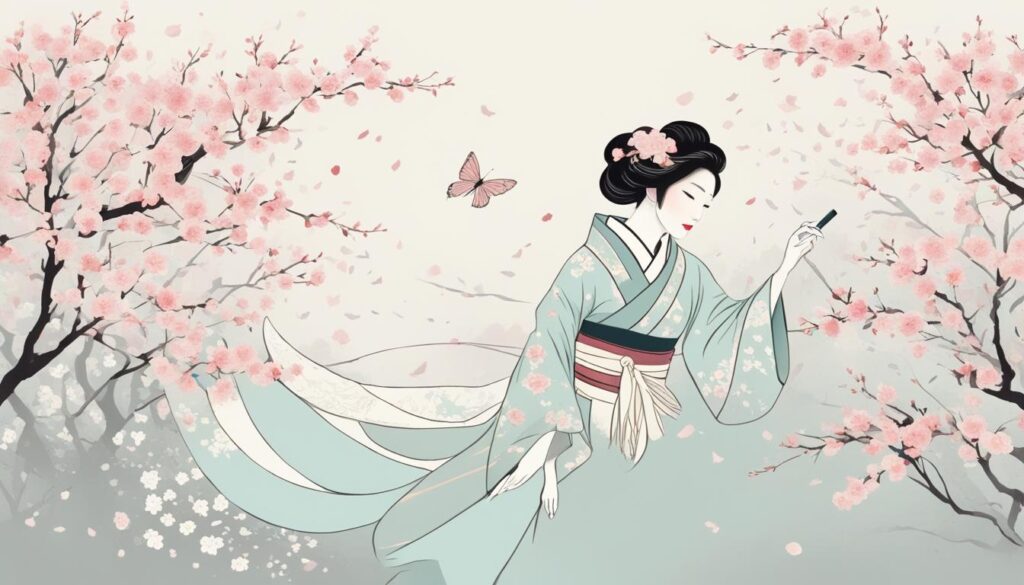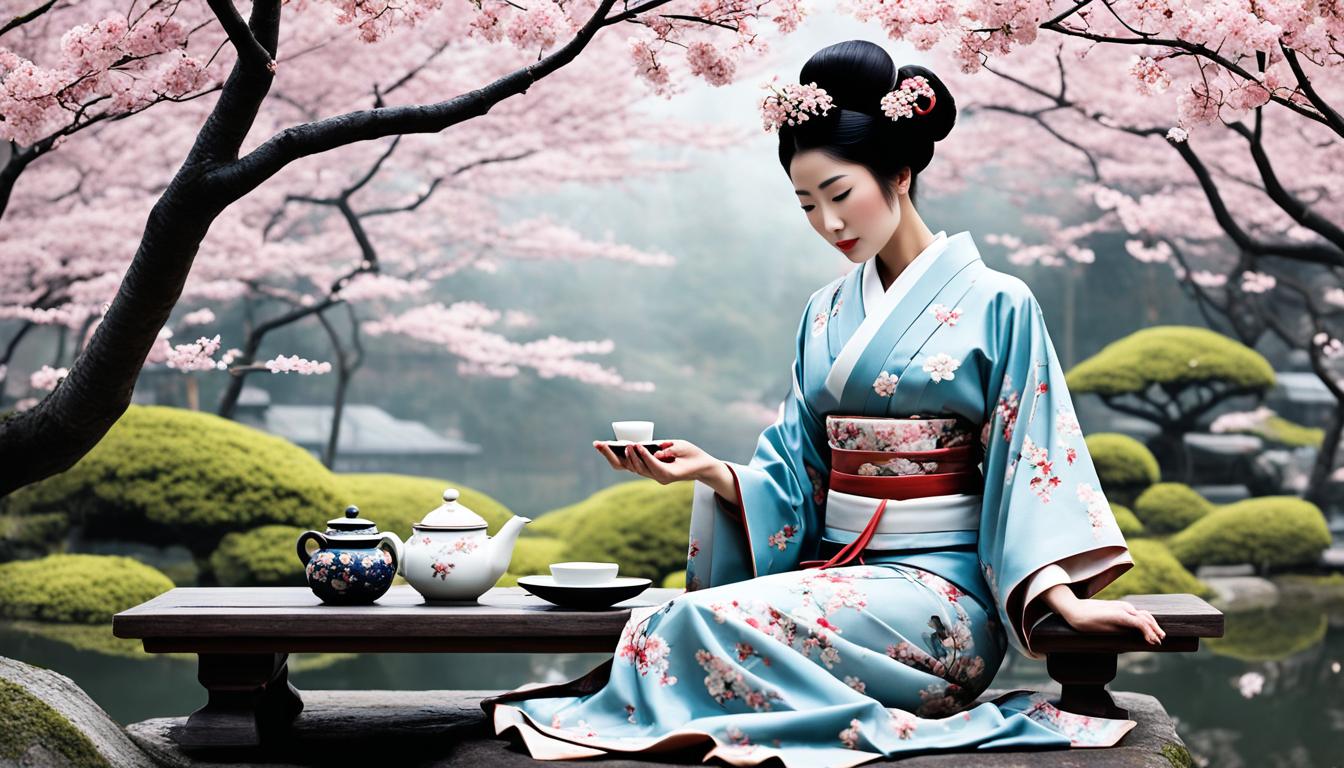Discover the beauty and tragedy of pre-war Japan in “Memoirs of a Geisha” by Arthur Golden. This captivating novel has become a beloved classic since its publication in 1997, and now, it is available as an audiobook. In this audiobook review, we explore the world of geishas through the eyes of a young protagonist and analyze the performance of the voice actor. Join us on this journey as we delve into the themes, characters, and cultural authenticity of “Memoirs of a Geisha.”
Overview of “Memoirs of a Geisha”
Arthur Golden’s “Memoirs of a Geisha” takes readers on a mesmerizing journey through pre-war Japan, immersing them in the fascinating world of geishas. The novel follows the life of Chiyo, a young girl sold to a geisha house, as she navigates the complexities of geisha life and eventually becomes the renowned geisha Sayuri.
The novel is set in the historically rich backdrop of pre-war Japan, depicting the customs, traditions, and social norms of the time, with a vivid and compelling narrative style. The themes of love, loss, sacrifice, and perseverance are interwoven into the plot, making for a truly immersive and emotional reading experience.
The book provides readers with a glimpse into the intricate world of geishas, showcasing the art of dance, song, conversation, and entertainment that made them such a vital part of Japanese culture. The novel also explores the challenges that geishas faced, including the male-dominated society and the inevitable conflict between personal desires and professional duties.
“Memoirs of a Geisha” is a stunning portrayal of a bygone era, capturing the essence of pre-war Japan, its culture, and its people, in a captivating and emotional story.
Plot Summary of “Memoirs of a Geisha”
Arthur Golden’s “Memoirs of a Geisha” is a captivating story set in pre-war Japan, following the life of a young girl named Chiyo who is sold into slavery in Kyoto’s geisha district. The novel’s plot revolves around her struggles and triumphs as a geisha named Sayuri, navigating through societal norms and cultural challenges.
As a child, Chiyo is sold by her impoverished family and separated from her sister. Sold to a wealthy geisha house, she initially hates her new life, and becomes subject to terrible treatment from her peers. Things begin to change for her when a wealthy and influential client known as the Chairman shows her kindness, giving her hope for a better future.
In an effort to become a geisha like her role model and mentor Mameha, Sayuri endures rigorous training, including learning the art of dance, music, conversation, and tea ceremonies. Mameha uses her influence to help advance Sayuri’s career, which brings Sayuri success and admiration among her patrons.
Throughout the novel, Sayuri’s life is marked by key events involving her relationships with the Chairman, Nobu, and her best friend, Pumpkin. From the beginning, Sayuri has harbored deep feelings for the Chairman, although the two have never acted on them. Nobu, a wealthy Japanese businessman, becomes a new patron of Sayuri’s geisha house, and he and Sayuri develop a complicated relationship. Pumpkin, on the other hand, envious of Sayuri’s success, becomes a rival.
As Sayuri gains fame as a geisha, World War II engulfs Japan, adversely affecting her life and the lives of her loved ones. Sayuri’s former mentor Hatsumomo, who had tormented her for years, returns to the okiya, and Sayuri finds herself locked in a bitter feud with her. Despite these obstacles, Sayuri remains determined to achieve her dreams and overcome the many challenges that come her way.
“Memoirs of a Geisha” tells a captivating story of perseverance and the human spirit, beautifully capturing the complexities and nuances of Japanese culture during a tumultuous time in history.
Character Analysis of “Memoirs of a Geisha”
The characters in “Memoirs of a Geisha” are richly developed and offer a fascinating insight into the complex world of geishas in pre-war Japan. The protagonist, Chiyo, is a young girl sold into the geisha life, and her journey is marked by hardship, perseverance, and self-discovery.
Throughout the novel, Golden presents a range of geisha characters, each with their unique personalities, motivations, and relationships. Hatsumomo, for example, is a memorable character whose manipulative and jealous nature causes conflicts and tensions in Chiyo’s life.
Another fascinating character in the novel is the Chairman, a kind and compassionate man towards whom Chiyo develops strong feelings. The dynamics between these two characters are central to the plot and evoke a range of emotions in the reader.
The geisha characters in the novel are not portrayed as one-dimensional caricatures but rather as complex individuals dealing with their lives’ struggles in a harsh environment.
Character Traits Table
| Character | Traits |
|---|---|
| Chiyo/Sayuri | Determined, Observant, and Resilient |
| Hatsumomo | Jealous, Vengeful, and Manipulative |
| Mameha | Experienced, Wise, and Strategic |
| The Chairman | Kind, Compassionate, and Charismatic |
| Mr. Tanaka | Greedy, Controlling, and Ruthless |
“Memoirs of a Geisha” skillfully crafts characters that are both believable and compelling. Their interactions and struggles lead i read to form deep connections, further enhancing the book’s emotional impact.
Through detailed character analysis, readers can gain deeper insights into the complex world of geishas and the challenges they faced in pre-war Japan.
Writing Style and Language in “Memoirs of a Geisha”
Arthur Golden’s writing style in “Memoirs of a Geisha” is a masterful blend of vivid imagery, poetic language, and immersive storytelling. The author’s skillful use of literary techniques such as symbolism, metaphor, and foreshadowing creates a richly textured world that transports readers to pre-war Japan.
The language used in the novel is elegant and evocative, reflecting the formality and ritualistic nature of the geisha culture. The use of Japanese words and phrases adds authenticity and depth to the narrative, while the frequent references to nature and the changing seasons imbue the story with a sense of timelessness and wonder.
Golden’s writing style is also notable for its ability to draw readers into the intimate thoughts and emotions of the characters. Through nuanced descriptions of body language, facial expressions, and fleeting glances, the author creates a powerful sense of empathy and understanding between the reader and the protagonist.

“Golden’s writing is so smooth and engrossing that it’s easy to lose yourself in the story, even when reading about unfamiliar cultural practices and customs. His use of language and literary devices elevates the novel from an entertaining read to a work of art.”
Symbolism and Imagery
One of the key elements of Golden’s writing style in “Memoirs of a Geisha” is his use of symbolism and imagery to convey deeper meanings and themes. Through the use of objects such as the cherry blossoms, the kimonos, and the teahouse, Golden imbues the novel with layers of meaning that reveal themselves slowly over the course of the story.
For example, the cherry blossoms, which are a recurring motif throughout the book, represent the transience of beauty and the impermanence of life. The kimonos, with their intricate designs and colors, reflect the geisha’s role as an artist and performer, while the teahouse symbolizes both the sanctuary and the prison of the geisha’s life.
The Impact on the Reader
Golden’s writing style and use of language contribute significantly to the impact that “Memoirs of a Geisha” has on the reader. By creating a detailed and immersive world populated by fully-realized characters, the author invites readers to invest in the story emotionally and intellectually.
The novel’s rich descriptions and poetic language combine to create a mesmerizing reading experience that stays with the reader long after the last page has been turned. In the end, it is Golden’s writing style and masterful storytelling that make “Memoirs of a Geisha” a true literary gem.
Audiobook Narration in “Memoirs of a Geisha”
Listening to an audiobook adds a unique dimension to the reading experience. The audiobook narration of “Memoirs of a Geisha” is no exception. The voice actor’s performance brings the story to life, immersing the listener into the world of pre-war Japan and geishas.
The portrayal of characters by the voice actor is remarkable, capturing their personalities and nuances with authenticity. The listener can discern the different voices and accents used for each character, enhancing their comprehension and enjoyment of the story.
The narrator’s tone and pace create a captivating auditory experience, maintaining a consistent level of energy and emotion throughout the book. The performance is engaging, evoking strong emotions and making the listener feel as though they are right there with the characters.
The audiobook narration of “Memoirs of a Geisha” is an excellent choice for those who want to experience the story differently. The overall performance by the voice actor adds an extra layer of charm and authenticity to an already captivating tale.
Historical and Cultural Accuracy in “Memoirs of a Geisha”
“Memoirs of a Geisha” is renowned for its intricate portrayal of Japanese life and culture in the pre-war era. Arthur Golden’s extensive research and attention to detail in the novel offer readers an authentic glimpse into the world of geishas and the broader Japanese society.
However, some critics have challenged the historical accuracy and cultural authenticity of the novel, citing inaccuracies in geisha traditions and customs. Despite these criticisms, “Memoirs of a Geisha” remains a powerful representation of the beauty and sacrifices of the geisha life.
The meticulous descriptions of the costumes, makeup, and performances of geishas in the novel demonstrate Golden’s commitment to historical accuracy. The portrayal of geishas as skilled entertainers and artists, rather than mere prostitutes, showcases their cultural significance within Japanese society.
Furthermore, Golden’s depiction of the pre-war era Japan captures the political, social, and economic realities of the time, providing readers with a vivid understanding of the war’s impact on Japanese citizens. “Memoirs of a Geisha” transports readers to a different time and place, and the historical and cultural accuracy of the novel makes this journey all the more meaningful.
Reception and Impact of “Memoirs of a Geisha”
Since its publication, “Memoirs of a Geisha” has gained critical acclaim and widespread recognition for its captivating storytelling and vivid portrayal of geisha culture in pre-war Japan. The novel was a commercial success, spending over two years on the New York Times Best Seller list and selling millions of copies worldwide.
Moreover, the book’s impact extends beyond its commercial success. “Memoirs of a Geisha” has received numerous awards and nominations, including the prestigious National Book Award and the James Tait Black Memorial Prize for Fiction. The novel has also been translated into over 30 languages, cementing its place as a global literary sensation.
The cultural significance of “Memoirs of a Geisha” cannot be overstated. The novel has played a pivotal role in shaping public perception and awareness of geisha culture, highlighting the artistry, tradition, and resilience of these iconic figures. The book has also inspired countless adaptations, including a Hollywood film adaptation directed by Rob Marshall in 2005, further cementing its lasting influence on popular culture.
“Memoirs of a Geisha” is a true masterpiece of literature, weaving together a compelling story with rich cultural insights and nuanced character development. Arthur Golden’s vivid portrayal of geisha culture has left an indelible mark on the literary world and popular culture at large.
Comparisons to Other Geisha-Related Works
While “Memoirs of a Geisha” stands out as a captivating geisha-themed novel, it is not the only work in this genre. In this section, we aim to compare and contrast “Memoirs of a Geisha” with other geisha-themed novels, providing a comparative analysis of their portrayal, storytelling, and themes. By examining these works side by side, we can gain a deeper understanding of what makes “Memoirs of a Geisha” unique and how it contributes to this genre.
| Novel Title | Author | Year | Key Similarities to “Memoirs of a Geisha” | Key Differences from “Memoirs of a Geisha” |
|---|---|---|---|---|
| Geisha, A Life | Mineko Iwasaki | 2002 | Firsthand account of geisha life | Non-fiction, written by a real-life geisha |
| Sayuri: The Memoirs of a Geisha | Rendell R.A. | 2016 | Similar plot and characters to “Memoirs of a Geisha” | Less critically acclaimed, derivative of the original |
| The Last Concubine | Lesley Downer | 2008 | Set in Japan, pre-war era | Main character not a geisha, different plot and themes |
While each of these geisha-themed novels explores the fascinating world of geishas in pre-war Japan, they each bring something unique to the table. “Geisha, A Life” offers a firsthand account of geisha life, written by a real-life geisha, while “Sayuri: The Memoirs of a Geisha” provides a plot and characters similar to “Memoirs of a Geisha,” but with less critical acclaim. “The Last Concubine” features a setting and historical context similar to that of “Memoirs of a Geisha,” but with a different plot and themes. Overall, “Memoirs of a Geisha” stands out among its counterparts for its captivating storytelling, richly developed characters, and cultural significance.
Analyzing the Audiobook Adaptation
Adapting a book-to-audio can be a complex process that requires careful consideration of creative choices to ensure the audio format stays true to the original story. In the case of “Memoirs of a Geisha,” the audiobook adaptation by Random House Audio provides a fresh perspective on Arthur Golden’s work.
The narration by Bernadette Dunne brilliantly captures the nuances and emotions of the story, bringing the characters and settings to life in a way that transports listeners to pre-war Japan. The use of music and sound effects also adds to the overall impact of the audio experience, immersing listeners in the world of geishas.
The creative choices made by the production team, including the decision to use a female narrator and the use of traditional Japanese music, enhance the authenticity of the story and add to its cultural significance. Additionally, the audiobook’s pacing and structure effectively capture the ebb and flow of the plot, leaving listeners captivated and engaged from start to finish.
The use of audio as a storytelling medium offers a unique perspective on “Memoirs of a Geisha,” enriching the story in ways that may not have been possible through print alone. It’s clear that the production team had a deep appreciation for the source material and took great care in bringing it to life in an audio format.
“The audiobook enhances the overall reading experience, providing a fresh perspective on the story, and showcasing the creative possibilities of the book-to-audio format.”
Cultural Impact of “Memoirs of a Geisha”
“Memoirs of a Geisha” has had a significant cultural impact, extending beyond the literary world. The book’s film adaptation, released in 2005, brought the story to a wider global audience and further popularized the geisha culture.
The film, directed by Rob Marshall and starring Zhang Ziyi, Gong Li, and Ken Watanabe, was met with critical acclaim and was nominated for six Academy Awards, winning three. Its success helped to raise public awareness of geisha culture, but also generated controversy regarding the film’s casting choices and portrayal of Japanese culture.
The perception of geishas in Western culture has been greatly influenced by “Memoirs of a Geisha,” with many people seeing them as exotic, sexualized women. However, the book also shone a light on the harsh reality of the geisha life, including the strict training and often limited opportunities for personal choice and autonomy.
“I’d been unsure what to expect, but on the set, I discovered an entire universe full of people committed to bringing this story to life. The attention to detail was amazing” – Arthur Golden, author of “Memoirs of a Geisha”
The enduring impact of “Memoirs of a Geisha” can be seen in the continued fascination and interest in geisha culture, as well as the ongoing debate and discussion surrounding cultural appropriation and representation in media.
Critical Analysis of “Memoirs of a Geisha”
Arthur Golden’s “Memoirs of a Geisha” is a work of intricate storytelling, rich in symbolism and laden with themes and motifs. A literary analysis of the novel delves into the deeper meanings behind the story, exploring its relevance in a broader context.
One of the primary themes in “Memoirs of a Geisha” is the search for identity. As Chiyo, the protagonist, navigates a world full of societal constraints and cultural expectations, she struggles to reconcile her identity as both a geisha and a woman. The use of motifs such as the “water” and “snow” imagery, signifies the ever-changing and elusive nature of identity.
Another prominent theme is the commodification of women. The novel highlights how the geisha industry objectifies women’s bodies and commodifies their talents for men’s pleasure. This is exemplified in the crucial scene where Sayuri, the character’s geisha name, dances for the Chairman amid a room full of men.
The novel also reflects on the power dynamics between men and women, exploring issues of agency, powerlessness, and control. The character of Hatsumomo, another geisha, is a prime example of the predatory nature of male control over women’s lives.
Arthur Golden’s use of symbolism, such as the mizuage ceremony, which symbolizes the sexual exploitation of a young apprentice, and the constant reference to Sakuranbo’s cherry trees, highlights the Japanese cultural beliefs and the harsh realities of a geisha’s life.
“Memoirs of a Geisha” is a poignant and thought-provoking examination of the Japanese geisha culture, including the exploitation of women, the male dominance, and the search for personal identity, all set against the backdrop of pre-war Japan.
Through this critical analysis, readers can gain insight into the deeper implications of the novel and the significant role it played in highlighting the geisha industry’s inherent problems.
Reader Experiences and Reviews of “Memoirs of a Geisha”
The beauty of “Memoirs of a Geisha” lies in how it captivates readers from all walks of life. The story and characters have resonated with many, making it a beloved read for fans of historical fiction and engaging storytelling alike. Let’s take a look at some reader experiences and reviews:
“Arthur Golden’s book greatly moved me. I was impressed by the elaborate portrayals of the characters and the establishment of geisha life. It provides insight into the competitor’s side of a society that is often dominated by male dominance. I think it motivates the reader to learn more about Japanese history and culture, especially focused on geisha.”
“Memoirs of a Geisha was a captivating, emotional, and moving story. The intricate details that make up the life of a geisha were fascinating and eye-opening. The writing style was beautiful and created vivid imagery, bringing the story to life. Highly recommend this book to anyone who loves historical fiction.”
Many readers praise the rich character development and immersive writing style of “Memoirs of a Geisha.” Additionally, the book’s attention to historical accuracy and cultural authenticity has been commended, adding to its overall impact and appeal.

Conclusion
In conclusion, “Memoirs of a Geisha” by Arthur Golden is a beautifully written novel that transports readers to a fascinating world of geishas and pre-war Japan. The audiobook version of the book is equally captivating with a superb narration that brings the story to life.
Throughout this review, we have explored the plot, characters, writing style, cultural accuracy, and impact of the book. We have also compared it to other geisha-themed works, analyzed the audiobook adaptation, and offered a critical analysis of its themes and motifs.
This book has received critical acclaim and has had a lasting impact on literature and popular culture. It is a must-read for anyone interested in historical fiction and captivating storytelling.
In conclusion, “Memoirs of a Geisha” is a masterpiece that continues to captivate readers and listeners worldwide. It is a timeless work that deserves a spot on every bookshelf. If you haven’t read or listened to it yet, we highly recommend that you do so!



